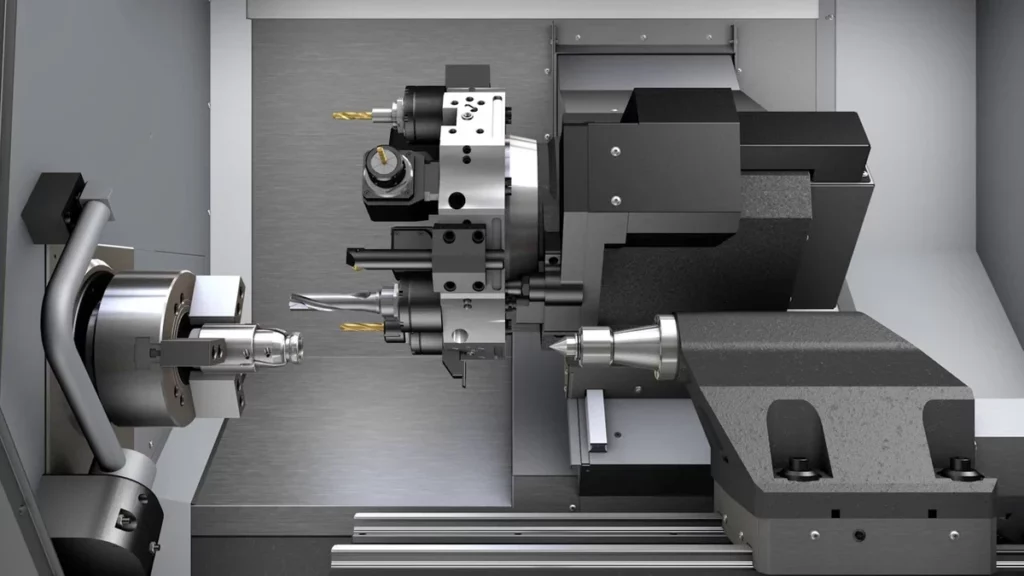In precision machining, CNC lathes and CNC turning centres are often mentioned interchangeably. However, they serve distinct purposes and cater to different manufacturing needs. Understanding the difference between a CNC lathe vs CNC turning centre is crucial in selecting the right machine for optimal efficiency, accuracy, and cost-effectiveness.
This article provides an in-depth comparison of CNC lathes and CNC turning centres, detailing their capabilities, advantages, limitations, and industrial applications. If you are looking to enhance your machining processes, this guide will help you make an informed decision.
What is a CNC Lathe?
A CNC lathe is a computer-controlled machine designed for turning operations on cylindrical workpieces. It automates cutting, drilling, and threading processes, ensuring precision and repeatability.
Key Features of CNC Lathes
- Single Spindle Rotation: The workpiece rotates while a stationary tool removes material.
- 2-Axis Motion (X & Z): Basic CNC lathes operate on two axes—X (crosswise) and Z (lengthwise).
- Tool Turret: Holds multiple cutting tools for various machining operations.
- Tailstock (Optional): Provides support for long workpieces.
Types of CNC Lathes
- Flat Bed CNC Lathes – Heavy-duty, suitable for large workpieces.
- Slant Bed CNC Lathes – Angled design for improved chip removal.
- Vertical CNC Lathes – Uses gravity to secure workpieces.
- Swiss-Type CNC Lathes – Ideal for small, precision components.
Advantages of CNC Lathes
- High Accuracy & Repeatability – Consistent precision due to computer control.
- Lower Initial Investment – Cost-effective for small to medium production.
- Simpler Operation – Easier to set up and operate than turning centres.
- Efficient for Cylindrical Parts – Perfect for symmetrical workpieces.
Limitations of CNC Lathes
- Limited to 2-Axis Machining – Cannot handle complex, multi-sided parts.
- Manual Tool Changes – Less automation compared to CNC turning centres
- Lower Productivity for High-Volume Manufacturing – Not optimised for mass production.
What is a CNC Turning Centre?
A CNC turning centre is an advanced version of a CNC lathe, equipped with multi-axis capabilities, live tooling, and automation for complex machining tasks.
Key Features of CNC Turning Centres
- Multi-Axis Control: Supports 3, 4, or even 5-axis machining.
- Live Tooling: Allows milling, drilling, and tapping in addition to turning.
- Dual Spindles: Enables machining on both ends of a workpiece.
- Automatic Tool Changer: Reduces downtime between machining operations.
- Fully Enclosed Design: Enhances safety by containing metal chips and coolant.
Types of CNC Turning Centres
- Horizontal Turning Centres – Common for general machining applications.
- Vertical Turning Centres – Designed for large, heavy workpieces.
- Twin-Spindle Turning Centres – Machining on both ends without repositioning.
- Multi-Axis Turning Centres – Advanced machines for intricate parts.
Advantages of CNC Turning Centres
- High Precision & Complexity – Capable of intricate, multi-sided machining.
- Increased Productivity – Multi-tasking reduces setup time and tool changes.
- Higher Automation – Suitable for large-scale production.
- Improved Chip Management – Slant-bed designs enhance efficiency.
Limitations of CNC Turning Centres
- Higher Initial Cost – More expensive than standard CNC lathes.
- Complex Setup & Maintenance – Requires skilled programming.
- Higher Operating Costs – More energy-intensive due to additional capabilities.
CNC Lathe vs CNC Turning Centre: A Detailed Comparison
| Feature | CNC Lathe | CNC Turning Centre |
| Machine Complexity | Simple turning operations. | Multi-axis with advanced functionalities. |
| Axis Capabilities | 2-axis (X, Z). | Up to 5-axis for complex machining. |
| Tool Changing | Manual or basic turret system. | Automatic tool changers. |
| Live Tooling | Not available or limited. | Supports drilling, milling, and tapping. |
| Spindle Configuration | Single spindle. | Dual spindles for simultaneous machining. |
| Production Volume | Best for small to medium runs. | Ideal for high-volume production. |
| Cost | Lower initial investment. | Higher cost but more capabilities. |
| Suitability | Cylindrical parts and basic machining. | Complex, multi-operation components. |
Choosing Between a CNC Lathe and CNC Turning Centre
1. Complexity of the Parts
- CNC lathes are best for simple, symmetrical parts.
- CNC turning centres excel in complex, multi-featured components.
2. Production Volume
- Small-batch or prototype production – CNC lathes are cost-effective.
- High-volume manufacturing – CNC turning centres provide better efficiency.
3. Budget Considerations
- CNC lathes have a lower upfront cost.
- CNC turning centres justify higher costs with added capabilities.
4. Automation & Labour
- CNC lathes require more manual intervention.
- CNC turning centres reduce labour costs with automation.
Industrial Applications
CNC Lathes Are Used In:
- Automotive: Shafts, gears, and bushings.
- Aerospace: Bearings, fasteners, and nozzles.
- Medical Devices: Surgical tools and bone screws.
- Electronics: Precision connectors and enclosures.
CNC Turning Centres Are Used In:
- Aerospace: Complex turbine components.
- Automotive: High-precision engine parts.
- Medical Industry: Custom implants.
- Oil & Gas: Valves, pipe fittings, and drill bits.
Final Thoughts
Both CNC lathes and CNC turning centres play vital roles in modern machining. The choice depends on the complexity, production volume, and budget.
- For simple, cylindrical parts, a CNC lathe is the best choice.
- For multi-tasking and high-speed production, a CNC turning centre is more efficient.
By selecting the right machine, manufacturers can improve productivity, accuracy, and cost-effectiveness.
If you’re looking for a reliable partner in precision engineering, Aeron Automation brings over 40 years of expertise, advanced CNC technology, and a dedication to quality. We deliver innovative, precision-engineered solutions with exceptional customer service. Ready to take your manufacturing to the next level? Contact Aeron today and see how our expertise can enhance your projects.
